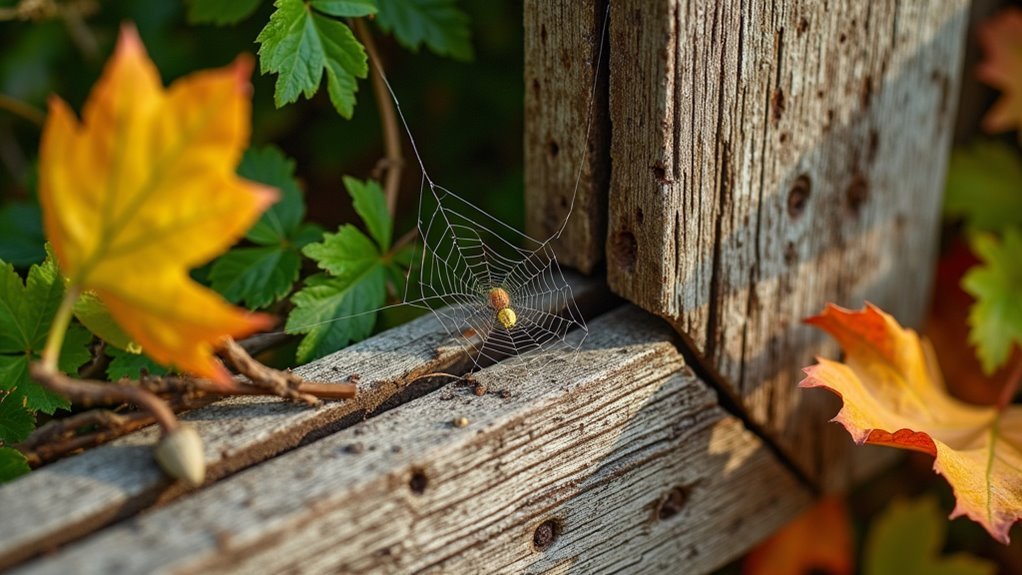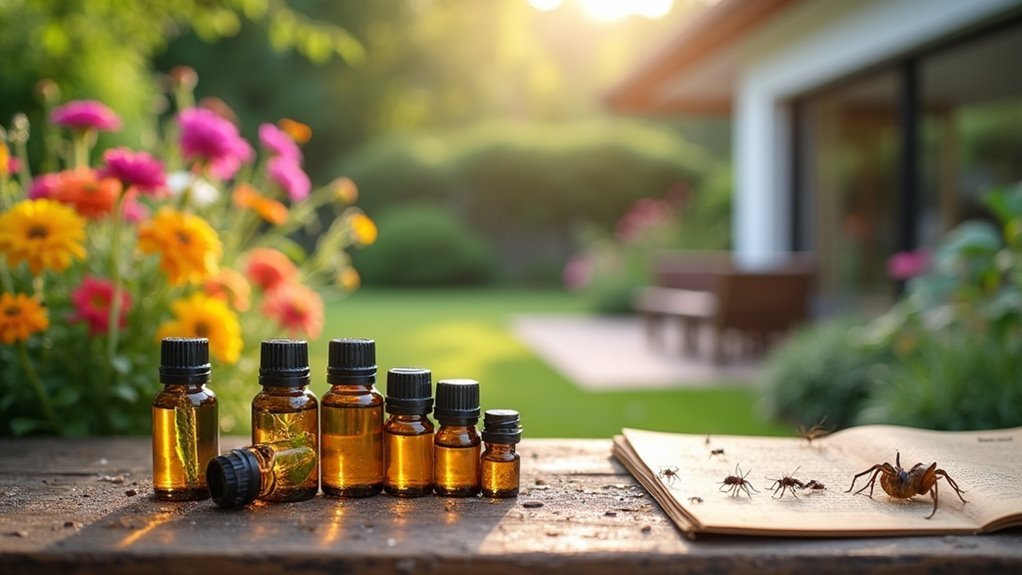You’ll need different pest prevention strategies throughout the year as seasonal temperature changes drive insects and rodents to seek shelter in your home. Spring requires sealing entry points and eliminating standing water to prevent ant and termite colonies. Summer demands frequent garbage disposal and intact window screens to block flies and mosquitoes. Fall means securing food storage and blocking access points before rodents move indoors. Winter calls for monitoring warm areas and maintaining proper ventilation. Discover extensive seasonal strategies ahead.
Understanding Seasonal Pest Behavior Patterns

As temperatures shift throughout the year, pest behaviors change dramatically, creating predictable patterns you can use to your advantage.
Understanding seasonal pest patterns helps you implement effective year-round pest control strategies.
Spring activates ants and termites as warming temperatures trigger reproduction, requiring immediate attention to prevent pests from establishing colonies.
Summer’s heat and humidity boost mosquito and fly populations around food sources that attract these common pests.
Autumn drives rodents indoors, making it essential to seal entry points before infestations begin.
Winter pushes cockroaches and spiders inside seeking warmth.
Regular inspections throughout each season enable proactive pest prevention.
Professional pest control services can identify vulnerabilities and recommend targeted pest management solutions based on these predictable seasonal behaviors, keeping your home protected year-round.
Spring Pest Prevention Strategies
When spring arrives, you’ll need to take immediate action to prevent pest infestations before they gain a foothold in your home.
Start by conducting thorough spring cleaning in basements and attics where pests commonly hide. Inspect and seal cracks around windows and doors to block entry points. Clean gutters and downspouts regularly to prevent water accumulation that attracts unwanted visitors.
Eliminate attractants by properly disposing of waste and securing food storage areas. Remove standing water sources, as they become breeding grounds for mosquitoes in warm conditions.
Regular inspections help you identify problems early before they escalate. Consider preventative treatment for vulnerable areas.
Summer Pest Control Tactics

Summer brings intense heat and humidity that create ideal breeding conditions for pests, making vigilant control tactics essential for protecting your home.
Focus on eliminating standing water from gutters, planters, and birdbaths where mosquitoes multiply rapidly. Inspect windows and doors for gaps, ensuring screens remain intact to block wasps, flies, and other summer pest invaders.
Store food properly in airtight containers and dispose of garbage frequently to avoid attracting pests like ants and cockroaches.
Maintain your yard by mowing regularly and trimming vegetation that harbors ticks and other unwanted visitors.
Conduct weekly inspections around your property, checking for nests, droppings, or unusual activity.
Effective summer pest control requires consistent prevention efforts rather than reactive treatments after infestations establish.
Fall Pest Management Techniques
As fall temperatures drop, you’ll need to shift your pest control strategy to focus on preventing rodents, spiders, and stink bugs from invading your home.
Your primary defense involves sealing entry points around your home’s exterior, removing outdoor food sources that attract pests, and clearing debris that provides shelter.
These proactive steps will keep unwanted guests outside where they belong during the cooler months.
Sealing Entry Points
Fall brings dropping temperatures that drive pests indoors, making your home a prime target for unwanted invaders. Sealing entry points becomes essential for effective home maintenance during this season.
You’ll need to inspect exterior areas thoroughly, focusing on cracks and gaps around windows, doors, and foundations. Mice can squeeze through openings as small as a dime, so don’t overlook tiny spaces.
Use caulk or foam to seal these vulnerabilities and prevent pest entry effectively. Replace damaged weather stripping to create better barriers against rodents seeking warmth.
Clear outdoor debris like leaves and mulch from your foundation to eliminate hiding spots. Pay special attention to areas around pipes, vents, and utility lines.
These proactive steps will keep pests out and prevent infestations. Consider professional pest control for extensive protection.
Eliminating Food Sources
When temperatures drop, hungry pests become more aggressive in their search for food, making your kitchen and pantry prime targets for invasion.
Eliminating food sources is one of the most effective pest control methods for preventing pests from establishing themselves in your home during fall.
Store all pantry items in airtight containers to block access from rodents and cockroaches. Cleaning up food spills immediately reduces the likelihood of pests discovering your space. Proper trash disposal using sealed containers removes tempting food sources that attract indoor and outdoor pest populations.
- Bring pet food dishes inside at night to prevent attracting nocturnal pests
- Remove waste frequently to eliminate lingering odors
- Maintain a clutter-free environment to reduce hiding spots
These strategies greatly decrease pest infestations throughout the season.
Outdoor Debris Removal
Fallen leaves, twigs, and organic debris create perfect shelter for rodents, insects, and other pests seeking winter hideouts near your home’s foundation. Regular outdoor debris removal is essential for effective seasonal pest prevention.
When you clear yard debris consistently, you’ll reduce hiding spots that attract unwanted visitors to your property. Maintaining a tidy yard prevents attracting pests that feed on decaying organic matter.
Properly disposing of fallen leaves, sticks, and mulch eliminates moisture accumulation that creates a breeding ground for mosquitoes and other insects. You should also trim overgrown plants and shrubs around your home’s perimeter, as these provide excellent shelter for various pests.
This cleanup process will improve air circulation and increase sunlight exposure, making your yard less hospitable for pest nesting and breeding activities.
Winter Pest Protection Methods
As temperatures drop and winter sets in, pests seek warm shelter inside your home, making proactive protection essential during these colder months.
Effective pest control requires sealing entry points where rodents can squeeze through openings as small as a quarter. These prevention strategies will help maintain a pest-free home throughout winter.
Focus on these critical winter protection measures:
- Seal vulnerable areas – Inspect gaps around doors, windows, and utility lines, plus repair garage door thresholds to block rodent access.
- Relocate firewood storage – Keep firewood at least 20 feet from your house and elevate it off the ground.
- Monitor for signs of pest activity – Check attics and basements for droppings and gnaw marks where rodents seek warmth, ensuring proper ventilation.
Essential Year-Round Maintenance Tasks

You’ll need consistent maintenance routines to keep pests away throughout the year, not just during peak seasons.
Monthly inspections help you spot potential problems early, while seasonal sealing tasks address vulnerabilities that change with weather conditions.
These proactive approaches form the foundation of effective pest prevention that adapts to your home’s shifting needs.
Monthly Inspection Routines
Everyone benefits from establishing a consistent monthly inspections routine that tackles pest prevention before problems escalate.
Your thorough approach should include checking your home’s exterior to seal gaps and identify entry points where rodents and insects might enter.
Don’t overlook these critical areas:
- Clean gutters and downspouts to eliminate standing water that attracts mosquitoes
- Monitor signs of pest activity in kitchens and basements, watching for droppings or nests
- Inspect pantry items for contamination while ensuring food stays in airtight containers
Maintaining a clutter-free environment prevents pests from finding shelter in debris piles or unused boxes.
These regular checks allow for early intervention when you spot problems, helping you maintain a pest-free environment year-round through proactive measures.
Seasonal Sealing Tasks
While monthly inspections help you spot potential problems, effective pest prevention requires consistent sealing tasks throughout the year to block entry points before pests discover them.
You’ll need to inspect and seal cracks and gaps around windows and doors regularly, using caulk or foam to fill in gaps around utility penetrations.
During warmer months, repair or replace damaged window screens to prevent flying insects while maintaining ventilation.
As temperatures drop, check weather stripping around doors to guarantee tight seals that prevent pests from entering.
Conduct biannual inspections of your home’s exterior to identify new openings that develop over time.
These proactive sealing tasks maintain a pest-free environment year-round.
Identifying and Eliminating Pest Attractants
Before pests can establish themselves in your home, they must find compelling reasons to stay. Identifying and eliminating these attractants is essential for preventing infestations and maintaining a pest-free environment year-round.
The most common attractants that draw pests include:
Pests seek three fundamental necessities in every home: accessible food sources, available moisture, and suitable shelter locations.
- Food sources – Store items in airtight containers and maintain consistent cleaning routines to remove crumbs and spills.
- Water accumulation – Fix leaky pipes, eliminate standing water, and guarantee proper drainage around your property.
- Shelter opportunities – Remove clutter that creates hiding spots and conduct regular inspections of storage areas.
Focus your efforts on sealing entry points around doors, windows, and utility penetrations.
Seal cracks immediately when discovered during inspections.
Remember that eliminating attractants works hand-in-hand with blocking access points to create thorough pest prevention throughout every season.
Treatment Vs Prevention Approaches
Although both treatment and prevention serve essential roles in pest management, understanding their fundamental differences will help you develop a more effective strategy for your home. Treatment involves reactive responses to existing pest infestations, requiring immediate action with specific products. Prevention emphasizes proactive measures like regular inspections and barrier treatments to stop problems before they start.
| Approach | Focus | Timeline |
|---|---|---|
| Treatment | Eliminate existing pests | Immediate action needed |
| Prevention | Stop pest infestations | Ongoing maintenance |
Effective pest management combines both approaches. You’ll need pest control strategies that address seasonal activity patterns throughout the year. While treatment resolves current issues, prevention through consistent inspections and proactive measures guarantees long-term pest management success for your property.
Frequently Asked Questions
How Many Times a Year Should You Go to Pest Control?
You should schedule pest control treatments at least four times yearly, once per season. If you’re dealing with termites or rodents, you’ll need more frequent visits every three to six months.
Is Pest Control All Year Round?
Yes, you’ll need pest control all year round since different pests emerge during each season. You can’t just treat once and forget—spring brings ants, summer mosquitoes, fall spiders, and winter cockroaches.
What Are the Three Basic Rules for Pest Prevention?
You’ll succeed with pest prevention by following three basic rules: seal all entry points like cracks and gaps, eliminate food and water sources that attract pests, and maintain consistent cleanliness throughout your home.
What Season Is Best for Pest Control?
Spring’s your best season for pest control since you’ll catch ants and termites before they become major problems. You’ll prevent structural damage by acting early when pest activity starts increasing after winter dormancy.
In Summary
You’re now equipped with a thorough pest prevention strategy that adapts to each season’s unique challenges. By implementing these year-round maintenance practices and staying ahead of seasonal patterns, you’ll create an environment that’s naturally resistant to infestations. Remember, prevention is always more effective and cost-efficient than reactive treatments. Stay vigilant, maintain consistency in your efforts, and you’ll keep your property pest-free throughout every season.





Leave a Reply